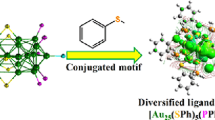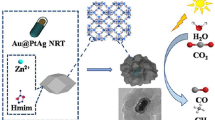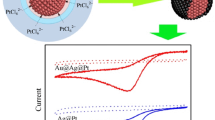Abstract
Galvanic replacement, one of the popular strategies for producing hollow metallic nanostructures, has enjoyed great success in the past. However, it is rarely used with Au nanoparticles as the self-sacrificed templates, even though these nanoparticles can be produced with well-controlled size, shape, and structure. Here, both Ag and Au from the core–shell Au@Ag nanorods are demonstrated to be involved in the galvanic replacement for producing hollow nanostructures. The enhanced oxidation of metallic Au could be attributed to the close contact between Au and Ag and the unique charge compensation from Au to Ag, both of which are indispensable for the etching of Au via galvanic replacement. As a result of this reaction, these bimetallic nanorods experience a structural evolution from nanorattles, to tip-empty nanorods, and eventually to porous nanotubes. The nanotubes exhibit high catalytic activities in the electrooxidation of formic acid. These results not only disclose the underlying mechanism by which metallic Au could be replaced under mild conditions, but also expand the selection of self-sacrificed templates for galvanic replacement, which is an important reaction in many applications.

Similar content being viewed by others
References
Fang, Z. C.; Wang, Y. C.; Liu, C. X.; Chen, S.; Sang, W.; Wang, C. Zeng, J. Rational design of metal nanoframes for catalysis and plasmonics. Small 2015, 11, 2593–2605.
Li, N.; Zhao, P. X.; Astruc, D. Anisotropic gold nanoparticles: Synthesis, properties, applications, and toxicity. Angew. Chem., Int. Ed. 2014, 53, 1756–1789.
Mahmoud, M. A.; Narayanan, R.; El-Sayed, M. A. Enhancing colloidal metallic nanocatalysis: Sharp edges and corners for solid nanoparticles and cage effect for hollow ones. Acc. Chem. Res. 2013, 46, 1795–1805.
Han, L.; Liu, H.; Cui, P. L.; Peng, Z. J.; Zhang, S. J.; Yang, J. Alloy Cu3Pt nanoframes through the structure evolution in Cu–Pt nanoparticles with a core–shell construction. Sci. Rep. 2015, 4, 6414.
Priebe, M.; Fromm, K. M. Nanorattles or yolk–shell nanoparticles—What are they, how are they made, and what are they good for? Chem.—Eur. J. 2015, 21, 3854–3874.
Xia, X. H.; Wang, Y.; Ruditskiy, A.; Xia, Y. N. 25th anniversary article: Galvanic replacement: A simple and versatile route to hollow nanostructures with tunable and well-controlled properties. Adv. Mater. 2013, 25, 6313–6333.
Gonzalez, E.; Arbiol, J.; Puntes, V. F. Carving at the nanoscale: Sequential galvanic exchange and kirkendall growth at room temperature. Science 2011, 334, 1377–1380.
Hong, X.; Wang, D. S.; Cai, S. F.; Rong, H. P.; Li, Y. D. Single-crystalline octahedral Au–Ag nanoframes. J. Am. Chem. Soc. 2012, 134, 18165–18168.
Wan, D. H. Xia, X. H.; Wang, Y. C.; Xia, Y. N. Robust synthesis of gold cubic nanoframes through a combination of galvanic replacement, gold deposition, and silver dealloying. Small 2013, 9, 3111–3117.
Shahjamali, M. M.; Bosman, M.; Cao, S. W.; Huang, X.; Cao, X. H.; Zhang, H.; Pramana, S. S.; Xue, C. Surfactantfree sub-2 nm ultrathin triangular gold nanoframes. Small 2013, 9, 2880–2886.
Ye, S. J.; Marston, G.; Mclaughlan, J. R.; Sigle, D. O.; Ingram, N.; Freear, S.; Baumberg, J. J.; Bushby, R. J.; Markham, A. F.; Critchley, K. et al. Engineering gold nanotubes with controlled length and near-infrared absorption for theranostic applications. Adv. Funct. Mater. 2015, 25, 2117–2127.
Sneed, B. T.; Brodsky, C. N.; Kuo, C. H.; Lamontagne, L. K.; Jiang, Y.; Wang, Y.; Tao, F.; Huang, W. X.; Tsung, C. K. Nanoscale-phase-separated Pd–Rh boxes synthesized via metal migration: An archetype for studying lattice strain and composition effects in electrocatalysis. J. Am. Chem. Soc. 2013, 135, 14691–14700.
Zhang, W. Q.; Yang, J. Z.; Lu, X. M. Tailoring galvanic replacement reaction for the preparation of Pt/Ag bimetallic hollow nanostructures with controlled number of voids. ACS Nano 2012, 6, 7397–7405.
Ye, X. C.; Jin, L. H.; Caglayan, H.; Chen, J.; Xing, G. Z.; Zheng, C.; Doan-Nguyen, V.; Kang, Y. J.; Engheta, N.; Kagan, C. R. et al. Improved size-tunable synthesis of monodisperse gold nanorods through the use of aromatic additives. ACS Nano 2012, 6, 2804–2817.
Zhang, Q. F.; Zhou, Y. D.; Villarreal, E.; Lin, Y.; Zou, S. L.; Wang, H. Faceted gold nanorods: Nanocuboids, convex nanocuboids, and concave nanocuboids. Nano Lett. 2015, 15, 4161–4169.
Takahata, R.; Yamazoe, S.; Koyasu, K.; Tsukuda, T. Surface plasmon resonance in gold ultrathin nanorods and nanowires. J. Am. Chem. Soc. 2014, 136, 8489–8491.
Fan, Z. X.; Bosman, M.; Huang, X.; Huang, D.; Yu, Y.; Ong, K. P.; Akimov, Y. A.; Wu, L.; Li, B.; Wu, J. et al. Stabilization of 4H hexagonal phase in gold nanoribbons. Nat. Commun. 2015, 6, 7684.
Wang, L.; Zhu, Y. H.; Wang, J. Q.; Liu, F. D.; Huang, J. F.; Meng, X. J.; Basset, J. M.; Han, Y.; Xiao, F. S. Twodimensional gold nanostructures with high activity for selective oxidation of carbon–hydrogen bonds. Nat. Commun. 2015, 6, 6957.
Langille, M. R.; Personick, M. L.; Zhang, J.; Mirkin, C. A. Defining rules for the shape evolution of gold nanoparticles. J. Am. Chem. Soc. 2012, 134, 14542–14554.
Quan, Z. W.; Wang, Y. X.; Fang, J. Y. High-index faceted noble metal nanocrystals. Acc. Chem. Res. 2013, 46, 191–202.
Guo, X., Ye, W., Zhu, R.; Wang, W. X.; Xie, F.; Sun, H. Y.; Zhao, Q.; Ding, Y.; Yang, J. Gold nanorod-templated synthesis of polymetallic hollow nanostructures with enhanced electrocatalytic performance. Nanoscale 2014, 6, 11732–11737.
Xue, M. M.; Tan. Y. W. Hollow alloy nanostructures templated by Au nanorods: Synthesis, mechanistic insights, and electrocatalytic activity. Nanoscale 2014, 6, 12500–12514.
Fan, N. N.; Yang, Y.; Wang, W. F.; Zhang, L. J.; Chen, W.; Zou, C.; Huang, S. M. Selective etching induces selective growth and controlled formation of various platinum nanostructures by modifying seed surface free energy. ACS Nano 2012, 6, 4072–4082.
Zou, R. X.; Guo, X.; Yang, J.; Li, D. D.; Peng, F.; Zhang, L.; Wang, H. J.; Yu, H. Selective etching of gold nanorods by ferric chloride at room temperature. CrystEngComm 2009, 11, 2797–2803.
Liu, M. Z.; Guyot-Sionnest, P. Synthesis and optical characterization of Au/Ag core/shell nanorods. J. Phys. Chem. B 2004, 108, 5882–5888.
Khalavka, Y.; Becker, J.; Sönnichsen, C. Synthesis of rodshaped gold nanorattles with improved plasmon sensitivity and catalytic activity. J. Am. Chem. Soc. 2009, 131, 1871–1875.
Hu, K. W.; Liu, T. M.; Chung, K. Y.; Huang, K. S.; Hsieh, C. T.; Sun, C. K.; Yeh, C. S. Efficient near-IR hyperthermia and intense nonlinear optical imaging contrast on the gold nanorod-in-shell nanostructures. J. Am. Chem. Soc. 2009, 131, 14186–14187.
Sreeprasad, T. S.; Samal, A. K.; Pradeep, T. Body- or tipcontrolled reactivity of gold nanorods and their conversion to particles through other anisotropic structures. Langmuir 2007, 23, 9463–9471.
Tsung, C. K.; Kou, X. S.; Shi, Q. H.; Zhang, J. P.; Yeung, M. H.; Wang, J. F.; Stucky, G. D. Selective shortening of single-crystalline gold nanorods by mild oxidation. J. Am. Chem. Soc. 2006, 128, 5352–5353.
Nishimura, S.; Dao, A. T. N.; Mott, D.; Ebitani, K.; Maenosono, S. X-ray absorption near-edge structure and X-ray photoelectron spectroscopy studies of interfacial charge transfer in gold–silver–gold double-shell nanoparticles. J. Phys. Chem. C 2012, 116, 4511–4516.
Anh, D. T. N.; Singh, P.; Shankar, C.; Mott, D.; Maenosono, S. Charge-transfer-induced suppression of galvanic replacement and synthesis of (Au@Ag)@Au double shell nanoparticles for highly uniform, robust and sensitive bioprobes. Appl. Phys. Lett. 2011, 99, 073107.
Maenosono, S.; Lee, J.; Dao, A. T. N.; Mott, D. Peak shape analysis of Ag 3d core-level X-ray photoelectron spectra of Au@Ag core–shell nanoparticles using an asymmetric Gaussian–Lorentzian mixed function. Surf. Interface Anal. 2012, 44, 1611–1614.
Shankar, C.; Dao, A. T. N.; Singh, P.; Higashimine, K.; Mott, D. M.; Maenosono, S. Chemical stabilization of gold coated by silver core–shell nanoparticles via electron transfer. Nanotechnology 2012, 23, 245704.
Zhang, Z. H.; Wang, Y.; Wang, X. G. Nanoporous bimetallic Pt–Au alloy nanocomposites with superior catalytic activity towards electro-oxidation of methanol and formic acid. Nanoscale 2011, 3, 1663–1674.
Xu, J. B.; Zhao, T. S.; Liang, Z. X. Synthesis of active platinum–silver alloy electrocatalyst toward the formic acid oxidation reaction. J. Phys. Chem. C 2008, 112, 17362–17367.
Venkateswara Rao, C.; Cabrera, C. R.; Ishikawa, Y. Graphene-supported Pt–Au alloy nanoparticles: A highly efficient anode for direct formic acid fuel cells. J. Phys. Chem. C 2011, 115, 21963–21970.
Ren, H.; Humbert, M. P.; Menning, C. A.; Chen, J. G.; Shu, Y. Y.; Singh, U. G.; Cheng, W. C. Inhibition of coking and CO poisoning of Pt catalysts by the formation of Au/Pt bimetallic surfaces. Appl. Catal. A: Gen. 2010, 375, 303–309.
Author information
Authors and Affiliations
Corresponding author
Electronic supplementary material
Rights and permissions
About this article
Cite this article
Sun, H., Guo, X., Ye, W. et al. Charge transfer accelerates galvanic replacement for PtAgAu nanotubes with enhanced catalytic activity. Nano Res. 9, 1173–1181 (2016). https://doi.org/10.1007/s12274-016-1011-3
Received:
Revised:
Accepted:
Published:
Issue Date:
DOI: https://doi.org/10.1007/s12274-016-1011-3




